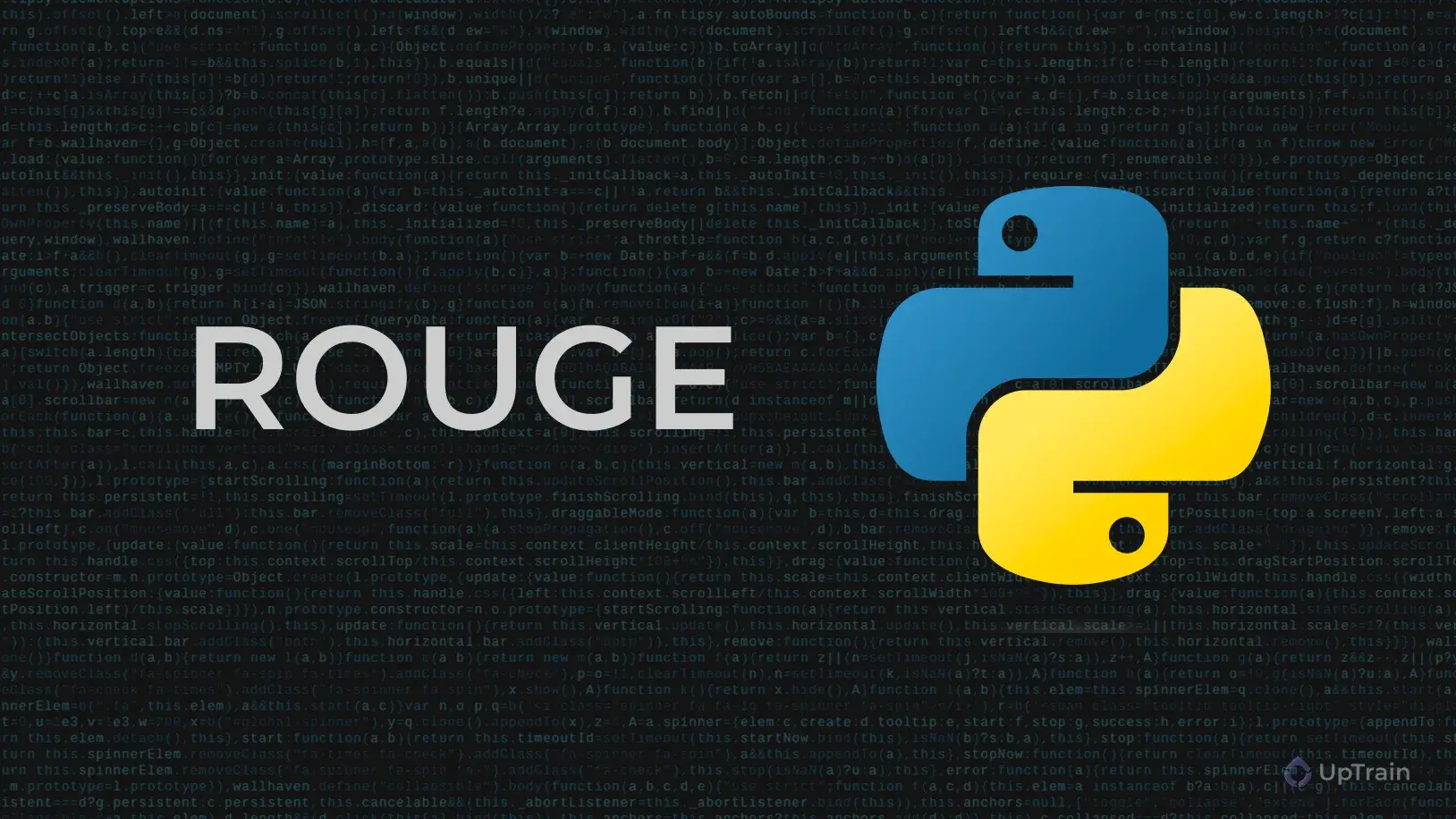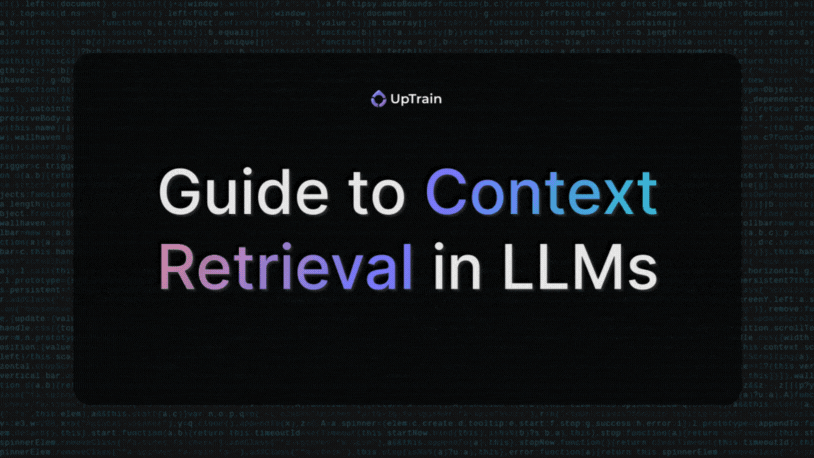In the realm of Large Language Models (LLMs), one term that frequently emerges is “ROUGE Score.” But what exactly is ROUGE, and why is it of paramount importance in the world of natural language processing and AI?
ROUGE is a critical metric that measures the similarity between generated text and reference text by focusing on recall. It comprises three main types: ROUGE-N, which assesses n-gram overlap; ROUGE-L, which identifies the Longest Common Subsequence; and ROUGE-S, which concentrates on skip grams. Among these, ROUGE-N, which measures n-gram overlap, is the most commonly employed type.
The formula for ROUGE-N typically follows the pattern:

The ROUGE Score Unveiled
ROUGE, which stands for Recall-Oriented Understudy for Gisting Evaluation, is a metric used to assess the quality of machine-generated text, especially when compared to human-generated reference texts. It plays a pivotal role in the evaluation of content generated by Large Language Models, making it a crucial tool in natural language processing and text generation.
At a minimum, this metric takes as input a list of predictions and a list of references:
>>> rouge = evaluate.load('rouge')
>>> predictions = ["hello there", "general kenobi"]
>>> references = ["hello there", "general kenobi"]
>>> results = rouge.compute(predictions=predictions,
... references=references)
>>> print(results)
{'rouge1': 1.0, 'rouge2': 1.0, 'rougeL': 1.0, 'rougeLsum': 1.0}

Use Cases and Importance of ROUGE SCORE
ROUGE Score finds its application in various domains, including:
1. Machine Translation: It’s used to evaluate the quality of machine-translated text by comparing it to human translations. ROUGE helps identify the accuracy and fluency of the generated content.
2. Summarization: ROUGE is employed to assess the effectiveness of text summarization algorithms by comparing the generated summary to human-generated summaries. It ensures that essential information is not lost in the summarization process.
3. Document Retrieval: In information retrieval tasks, ROUGE is used to measure the similarity between the content retrieved by a search engine and the content present in the documents. It ensures that the retrieved documents are relevant and coherent.
4. Content Generation: When it comes to LLMs and AI-driven content generation, ROUGE Score is employed to assess the quality and coherence of the generated text. It’s an essential tool for ensuring that AI-generated content aligns with human standards.
ROUGE Score is crucial in these use cases because it quantifies the level of similarity between machine-generated text and reference text, offering a standardized approach for evaluating the quality of AI-generated content.
Calculating ROUGE Score
ROUGE Score is calculated by comparing the machine-generated text to one or more reference texts created by humans. The most common ROUGE metric is ROUGE-N, which assesses the overlap of n-grams (contiguous sequences of n words) between the machine-generated text and the reference text.
Here’s a simplified breakdown of how ROUGE-N is calculated:
- Tokenization: Both the machine-generated text and the reference text are tokenized, breaking them into individual words or subword tokens.
- N-grams: For a specific value of ‘n’ (e.g., bigrams for ‘n=2’), all possible n-grams are extracted from both the machine-generated text and the reference text.
- Overlap Calculation: The number of overlapping n-grams between the machine-generated text and the reference text is counted. This represents the commonality between the two texts.
- Precision and Recall: ROUGE-N calculates precision (the number of overlapping n-grams divided by the total number of n-grams in the machine-generated text) and recall (the number of overlapping n-grams divided by the total number of n-grams in the reference text).
- F1 Score: The F1 Score, which is the harmonic mean of precision and recall, provides a single metric to gauge the quality of the machine-generated text.
ROUGE-N can be extended to ROUGE-L (measuring longest common subsequence), ROUGE-W (measuring weighted longest common subsequence), and more, depending on the specific evaluation requirements. Each of these metrics offers a distinct perspective on the quality of the generated content.

ROUGE Score in Real-Life Scenarios
To grasp the practical significance of ROUGE Score, let’s delve into real-life scenarios where it plays a crucial role.
Machine Translation
Imagine a scenario where a global e-commerce company uses machine translation to make its product descriptions available in multiple languages. ROUGE Score comes into play when evaluating the quality of translations. A low ROUGE Score could indicate that the machine-generated translations are inaccurate, potentially leading to misunderstandings and negatively impacting sales. In contrast, a high ROUGE Score ensures that the translated content is not only accurate but also aligns with the linguistic nuances of the target audience.
Content Summarization
In the realm of news agencies, where the demand for quick, concise news summaries is immense, ROUGE Score aids in evaluating the performance of automatic summarization algorithms. A high ROUGE Score indicates that the generated summary effectively captures the key points of the news article. This ensures that readers receive the necessary information without having to go through the entire article, ultimately saving time and enhancing user experience.
Search Engine Optimization
For an e-learning platform, SEO optimization is vital to ensure that the right content is delivered to learners. ROUGE Score can be used to assess the relevance and coherence of the content retrieved by the search engine. If the ROUGE Score is low, it might mean that learners are not getting the most relevant educational material, leading to a suboptimal learning experience. In contrast, a high ROUGE Score ensures that the content retrieved aligns with the learners’ needs, fostering effective learning outcomes.
AI-Driven Content Generation
In content marketing, where AI-driven content generation tools are used to create articles, blog posts, and product descriptions, ROUGE Score serves as a critical measure of quality. High ROUGE Scores indicate that the generated content is not only coherent but also aligns with the tone and style expected by the target audience. On the other hand, a low ROUGE Score might signify that the AI-generated content lacks relevance and might not resonate with readers.

Issues with ROUGE Score
While ROUGE Score is a valuable tool for evaluating machine-generated content, it is not without its limitations. Some of the common issues with ROUGE Score include:
1. Limited to Surface-Level Evaluation:ROUGE Score primarily focuses on the overlap of n-grams between machine-generated and reference texts. It may not capture the overall coherence and context of the content.
2. Sensitivity to Minor Changes: ROUGE Score can be sensitive to minor differences in wording. A small change in a sentence can significantly impact the ROUGE Score, even if the overall meaning remains intact.
3. Lack of Semantic Understanding: ROUGE does not possess semantic understanding. It evaluates content based on word patterns and sequences, which may not reflect the true meaning of the text.
4. Reference Text Dependency: The quality of the reference text plays a crucial role in ROUGE evaluation. If the reference text is of low quality or contains errors, it can lead to inaccurate ROUGE Scores.
UpTrain: A Superior Solution
While ROUGE Score is a valuable metric for evaluating machine-generated content, it is not a standalone solution for addressing the complexities of content quality assessment in the AI landscape. This is where UpTrain emerges as a superior solution.
UpTrain is an AI-powered platform that offers a holistic approach to content generation and evaluation. It goes beyond the limitations of ROUGE Score and provides a comprehensive solution for ensuring high-quality, relevant, and coherent content. Here’s why UpTrain is the superior choice:
Semantic Understanding
UpTrain incorporates advanced natural language understanding capabilities, enabling it to assess content based on its meaning, context, and coherence. This goes beyond the surface-level evaluation of n-grams and ensures that the generated content makes sense and aligns with the desired tone and style.
Adaptability and Customization
UpTrain allows businesses to customize content generation models to meet their specific needs. It can adapt to industry-specific terminology, ensuring that the content is not only accurate but also domain-relevant.
Continuous Improvement
UpTrain promotes a culture of continuous improvement by leveraging user feedback and data-driven insights. It uses real-time monitoring and user feedback to enhance content quality over time, ensuring that the AI-generated content continually meets high standards.
Bias Mitigation
UpTrain includes bias detection and mitigation mechanisms to ensure that the generated content is free from biases and respects ethical standards. This is particularly crucial in sensitive domains such as healthcare and finance.
Comprehensive Content Evaluation
UpTrain offers a holistic approach to content evaluation. It goes beyond ROUGE Score to assess content quality regarding relevance, coherence, tone, and style. This ensures that the content generated meets the diverse needs of users.
To understand how to evaluate your LLM applications, you can refer to the website and check out the docs or book a call with us to get started with UpTrain.
Below is the code that allows you to check hallucinations, which is a step ahead of Rouge score between the input document text and LLM response.
from uptrain.framework import Check, CheckSet
from uptrain.operators import Histogram, Table, RougeScore
hallucination_check = Check(
name="hallucination",
operators=[
RougeScore(
col_in_generated="exp_generated",
col_in_source="document_text",
score_type="precision",
col_out="overlap_score",
),
],
plots=[
Histogram(
x="overlap_score",
nbins=20,
color="exp_LLM_PERSONALITY",
),
Table(title="Hallucination scores"),
],
)
Conclusion
In the world of Large Language Models and AI-driven content generation, ROUGE Score is undeniably a valuable metric for assessing content quality. It plays a critical role in evaluating machine-generated text in various domains, from machine translation to content summarization. However, it is not without limitations, as it primarily focuses on surface-level evaluation and does not possess semantic understanding.
While ROUGE Score has its place in content evaluation, UpTrain emerges as a superior solution for businesses and organizations that seek to ensure high-quality, coherent, and relevant content. With advanced natural language understanding capabilities, customization options, continuous improvement mechanisms, bias mitigation, and comprehensive content evaluation, UpTrain offers a holistic approach to content generation and assessment. It goes beyond the constraints of ROUGE Score and sets a new standard for AI-driven content quality. UpTrain is the path to superior content quality and user satisfaction in the ever-evolving landscape of AI and content generation.






Leave a Reply